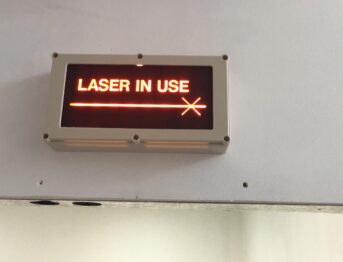
STEP 3:
Prepare Your Laser Room For QLD Licensing
In Queensland, it is mandatory to obtain a certificate of compliance for the room where laser procedures will be performed. This certificate must be delivered by a certified laser consultant.
K-Laser Australia offers this service to clients, ensuring that the laser treatment room meets all the necessary safety standards and regulations set forth by the Queensland health authorities.
Australian Laser Safety Standards
"Standards for premises-non-ionising radiations apparatus 2021"
In Queensland, obtaining a radiation license for laser use involves an assessment of the laser treatment room to ensure compliance with safety regulations.
The "Standard for premises-non-ionising radiation apparatus 2021" document outlines three compliance tests that must be met:
- Radiation warning signs: The laser treatment room must display appropriate warning signs indicating the presence of laser radiation.
- Contaminant control equipment: The room must be equipped with appropriate measures to control contamination, including protective clothing, ventilation systems, and waste disposal systems.
- External radiation levels: The radiation levels outside the treatment room must not exceed safe levels.
Test 1 - Radiation Warning Sign


The warning sign includes two parts
- A sign attached to the door,
- A light situated above the door.
1 - The sign attached to the door must include:
- A laser hazard symbol
- A specific wording on the sign should includes "warning - laser on - do not enter when light is illuminated" and "eye protection must be worn."
2 - The light situated above the door
You have the option to use a simple light bulb or a fancy lighting box for the light above the door. However, it is important to ensure that the light switch is located inside the laser room, either connected through an electric cable or with a remote control.
Every entrance to the laser room must adhere to the compliance standards. This means that if the room has multiple doors, a warning sign must be installed above each one.
Test 2 - Contaminant Control Equipment
The K-Laser Fume Extractor is designed to retain 99.99% of air contaminants. It comes with a pre-filter and main filter that needs to be changed once a year or when indicated by the device.
The ventilation system
According to the AU standard document, a fume extractor is only necessary for lasers that produce significant airborne contaminants, such as ablative lasers used for surgical procedures. Therapy and vascular lasers do not require one.
However, if a fume extractor is used, the ventilation system must be appropriate to prevent contaminants from being passed downstream in the air handling/exhaust system.
It is important to keep a record of filter changes and maintenance as per the manufacturer's instructions as proof of maintenance.
Test 3 - External Radiation Levels

Windows & Open Spaces
Lasers emit non-ionizing radiation that can still harm eyes.
If there are windows in the laser room, curtains, blinds, or opaque films must be installed to cover the entire window. It is important to ensure that there are no gaps or free space between the window and the wall that could allow the laser beam to pass through.
This includes high windows in the ceiling.
Include it in your Radiation Safety and Protection Plan (RSPP)
Anything that can be easily removed is not considered permanent and must always be kept in the room and ready to be installed.
This information must be included in the laser safety procedure checks of the clinic's RSPP.
For instance, an example of a safety procedure is to lower the window blinds.
Additional Safety Risks
In Queensland, when applying for a possession license, a Radiation Safety Protection Plan (RSPP) must be drafted. This is a comprehensive legal document that assesses the potential risks of using lasers in the clinic.
The type of laser being purchased will determine the specific requirements for preparing the laser room and mitigating risks:
- Fire hazard,
- Electricity hazard,
- Eye damage hazard,
- Skin/burn hazard.
Fire Hazard
K-Laser diode lasers have a low risk of fire.
- For the K-Laser Therapeutic laser model for pain management, it is recommended to prepare the laser room with a fire blanket.
- For the K-Laser Cosmetic laser model, it is recommended to prepare the laser room with a fire extinguisher.
It is important to record the presence of a fire blanket or fire extinguisher in the laser room in your RSPP.
Eye Damage Hazard
CLASS IV LASERS
To comply with the safety regulations for class 4 laser, it is important to ensure that any direct or indirect laser beam should not reach the eyes. Therefore, it is necessary to wear eye protection that is specific to the wavelengths of your laser.
Additionally, any source of reflection such as mirrors, shiny metal on door handles, trolleys, foot stools, sink taps, hangers, frames, etc. should be removed or covered to prevent the laser beam from reflecting off and causing harm.
To ensure the safety of everyone in the laser room, it is recommended to include these safety measures in the RSPP of the clinic's laser safety procedure checks. Anything that is not removed and is considered shiny should be covered and listed in the RSPP.
For example, covering the tap and sink with a blanket can be a safety measure to prevent any harmful laser reflection.
Electricity Hazard
K-Laser diode lasers have a low risk of electric shock.
Our lasers can be easily connected to a standard 220W power outlet without requiring any specialised electrical installation or three-phase power.
As with any electrical appliance, standard safety precautions should be taken, such as keeping the laser away from water. There are no additional requirements from the RSPP for K-Laser units.
Skin / Burn Hazard
- For K-Laser Therapeutic Units designed for pain management, the likelihood of burns is low, but misuse of the laser can still result in burns.
- For K-Laser Cosmetic & Surgical Units, burning of tissue to remove skin lesions is an expected outcome. It is advisable to keep cooling packs, ice packs, or a fan in the clinic to help manage any discomfort experienced by the patient during the procedure.
NEXT STEP
NEXT STEP
Contact Us
Discuss Your Needs
Request Demonstration
Consider Your Options
Get A Price

